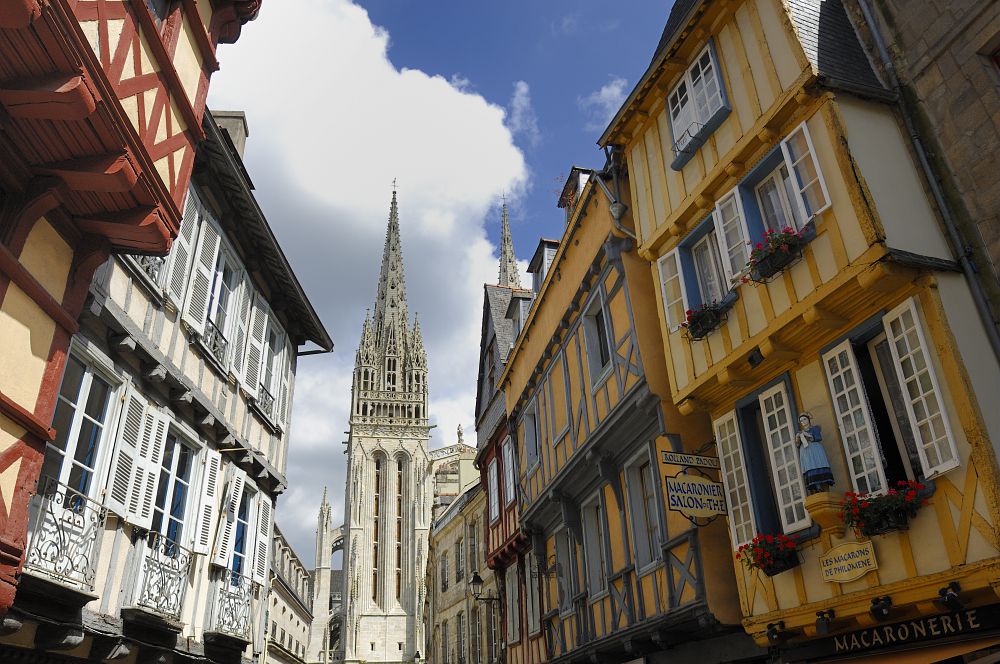
Quimper, the capital of Cornouaille, is one of the largest cities in Brittany and the capital of Finistère and the Cornouaille region. The old episcopal town of Quimper bears the title “Ville d’art et d’histoire”. For lovers of art and culture, a visit to Quimper should be on the must-do list.
Before heading to the city’s museums, a tour of the multifaceted Quimper is recommended. From one of the car parks in the centre, for example the Parking Tour d’Auvergne in the square of the same name, you can stroll around the various districts of the city.
Discover now:
- A Walk Through Quimper
- Attractions & Museums In Quimper
- Crêperies At Place au Beurre
- Porcelain From Quimper
A Walk Through Quimper
Adjacent to the pay car park is the “Théatre de Cornouaille”, one of the most prestigious venues in all of Brittany. Standing in front of the building, the tour of the centre begins on the right in Rue Laennec. After a few steps, Rue de Falkirk crosses the way. On the other side of the street, Rue Laennec becomes a pedestrian zone with pubs and shops.
Keep left at the end of the street and turn right into Rue Astor at the next small square (where market stalls are regularly set up). Within sight, a tributary of the Odet gurgles happily through Quimper and the indoor market also appears on the scene. A detour through “les halles” is always worthwhile, even if you don’t buy anything, just for the worthwhile displays of the stalls.
Attractions & Museums In Quimper
After strolling through Quimper’s market hall, turn left at the north-eastern end of the building and after a few metres turn right, directly towards Quimper Cathedral. An imposing building, this Cathédrale Saint-Corentin, which also gives its name to the town’s central square.
The towers rise 75 metres into the air and dominate the silhouette of the city centre. The church building is a mix of different styles, which is mainly due to the fact that several architectural epochs lie between the start of construction in 1239 and the completion in 1856. Numerous interesting details inside and out make the church a popular tourist attraction.
Directly opposite the Saint-Corentin Cathedral, the “Musée des Beaux Arts” attracts admirers of painting. The Museum of Fine Arts mainly houses paintings from the 16th – 18th centuries. Modern art is represented by artists of the Pont-Aven school and the painter-poet Max Jacob, the city’s most famous son along with the inventor of the stethoscope, René Laënnec. Admission costs 5 euros, concessions 3 euros.
Admission is free for anyone who has previously visited the other 3 museums in Quimper and can show the Quimper museum pass (cost: 12 euros). The other museums are the Breton Departmental Museum (Musée Départemental Breton), the Museum of Contemporary Art (Centre d’Art Contemporain) and the Porcelain Museum (Musée de la Faïence).
Crêperies At Place au Beurre
Busy walkers may feel hungry after this part of the tour. At Place au Beurre, not far from the northern exit of Place Saint Corentin, Quimper’s top-rated crêperies welcome their guests. Unfortunately, addresses like the Crêperie Krampouzerie or the Crêperie Place au Beurre are not really insider tips. Word has got around about the high quality of the galette, and some gourmets even think that the best crêpes in all of Brittany are prepared here.
In addition to the great success, the restaurants are located in narrow houses and have only a few tables. Galette lovers must therefore be prepared for the sign “Nous sommes complete” outside the door. Alternatively, there are restaurants in the city centre, such as “Le Finistère” on Place Saint-Corentin or “Le Cariatides” on Rue du Guéodet.
Porcelain From Quimper
Every Brittany holidaymaker will notice the blue and white bowls with names on the outside, which can be found in almost every souvenir shop. This beautiful porcelain comes from Quimper. Decorated with flowers, birds and figures in Breton costume, the bowls are perfect for cereal, fruit or dessert. The bowls are rather unsuitable for drinking coffee or cider. There are special bolée for that.
The finest bowls of this kind come from the Henriot manufactory. Since 1690, the porcelain makers of Henriot in Quimper have been producing decorative plates, vases, cups and figurines. The manufactory is located on Place Bérardier in the Locmaria district, a stone’s throw from the Porcelain Museum. The manufactory offers one-hour guided tours, and tour guides are also available in German. All the fantastic porcelain is then available for purchase in the shop, here is a virtual impression. Thanks to an exclusive service, the shop also accepts orders for individual bowls. However, it takes a few weeks before you can hold a bowl in your hands with your own name (or that of someone who will surely be surprised).
Images: Comité Régional du Tourisme de Bretagne | © Yanick Le Gal,
